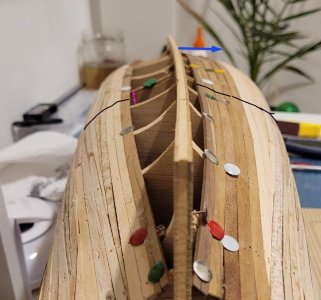
, you've already gotten some good advice. I'm just going to state how I would tackle it if it were my problem to deal with.
I think I would sand/taper that center piece using the bulkheads as the guide. The goal would be to just create a base that you could complete that first layer of planking over, not paying any attention to the lateral curve of the centerboard. I would try to get a nice, smooth full layer of planking over the entire bottom of the hull. Then when you glue on the actual keel piece, you could ensure it follows a nice straight path from bow to stern, and once the second layer of planking is laid to go with it, no one will know the mess that's underneath.
In fairness, I might be more concerned with if the masts will tend to be leaning to port or starboard if the centerblock they bottom out on is off to one side due to that curve. Not unresolvable, just something to keep in mind once you start the masting and rigging process. You can always let the base of the mast "float" in the space, and just let the shrouds and stays keep the masts in their proper alignment Good luck with your project. I'm sure you can rescue it.












 , you've already gotten some good advice. I'm just going to state how I would tackle it if it were my problem to deal with.
, you've already gotten some good advice. I'm just going to state how I would tackle it if it were my problem to deal with.